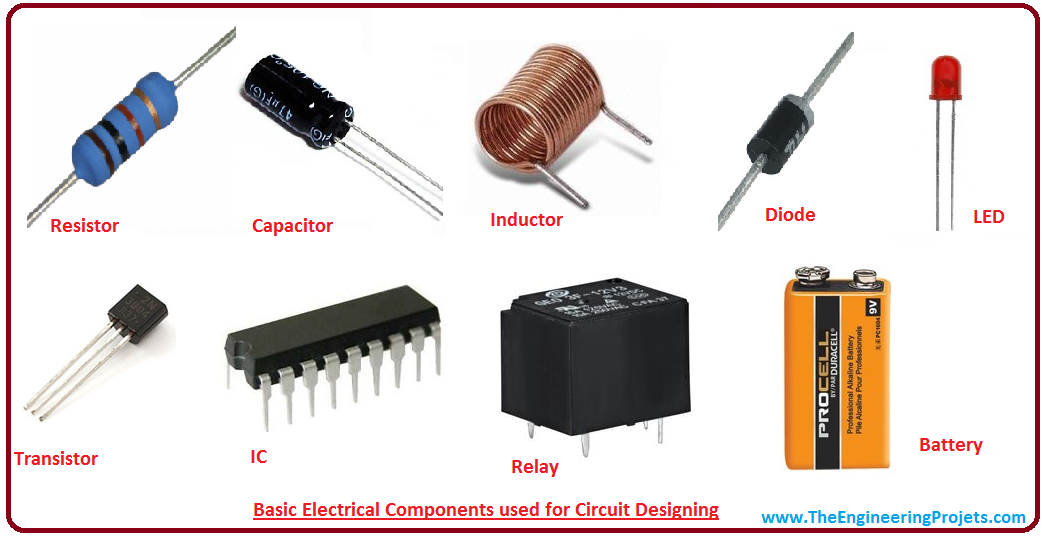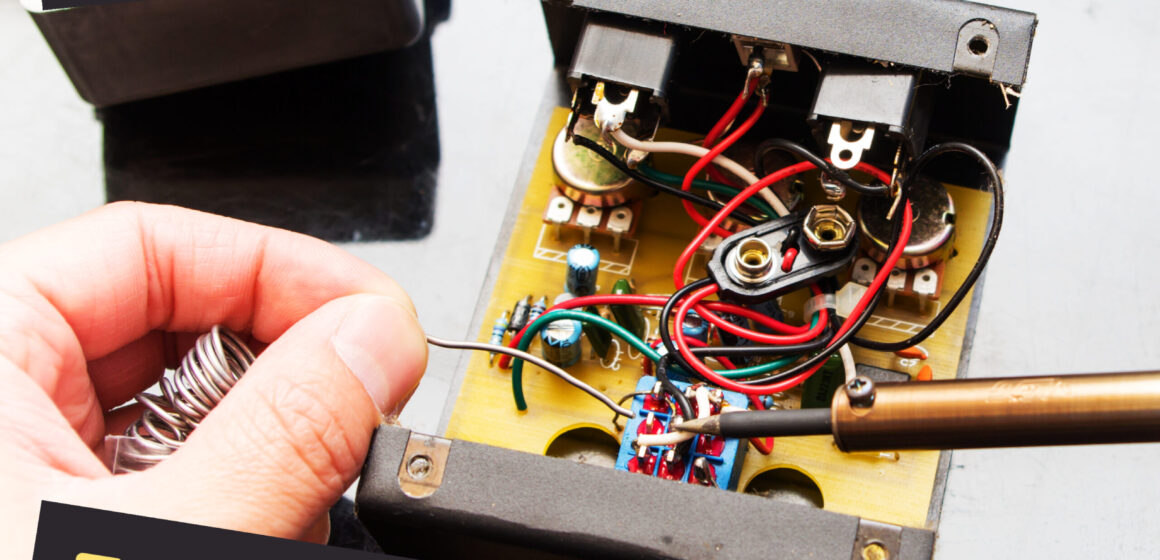Basic Components for Electronics
Basic components in electronics are all around us, but most people don’t really know how they work! It’s crazy to think that almost every device from the smallest computer mouse to the biggest airplane all function with a handful of tiny components – it’s really like Legos for engineers! It isn’t difficult to get started with electronics. This blog will inform you about what each unique component commonly does, and further posts will give some ideas about how to use those components in cool circuits! Keep in mind that this will have a slight bias toward audio – I’ve worked on a lot of amps, speakers, keyboards, and pedals!
Power Source:
Electricity is generated in two ways: Alternating Current (AC), and Direct Current (DC). Now you know why the rock band AC/DC has a lightning bolt in their logo! AC is what runs through your house and most buildings. AC is dangerous and can cause bodily harm (or worse!) if you get zapped. DC is what almost all small devices like computers, phones, TVs, and more run on internally. Most DC devices don’t have a ton of voltage, and oftentime DC isn’t that dangerous. Most basic electronics projects run on 9v DC current, or the same power as a 9v battery. If you’ve ever licked a 9v, you know it’s not so bad. 😉
Almost all circuits need active power to function.
Resistors:
Ah yes, the mighty resistor. The true workhorse of every electronic circuit and one of the most basic components. A resistor’s job is simply to resist the flow of electrical current. A resistor doesn’t stop electricity, it just slows it down and reduces its power. We commonly think of electricity like a flowing river – in this example, a resistor would be a big boulder that slows down the water as it rushes by. Resistors have color bands on them. These bands tell you how strong the resistor is, or what its value is. Resistance is measured in Ohms, or Ω.
Technician Hint: Resistors rarely fail, and when they do, it’s pretty obvious. Look for burnt or discolored resistors in your non-functional devices. Resistors can fail open or closed, meaning that bad ones can either allow the electricity to pass unimpeded or will completely block the current altogether.
Diodes:
Diodes are awesome little guys that fill a couple of important roles. The most unique quality of a diode is that it only allows current to flow in one direction. Every diode has polarity, or a positive and a negative side. Flipped one way, the diode will prevent all current from passing through the circuit. Flipped the other way, and the circuit will receive power.
Almost all devices include a diode for polarity protection. This brave little guy stands faithfully by the incoming power and will sacrifice himself if there is a surge, or if someone plugs in the wrong power adapter. By doing so, his noble death saves the rest of the circuit from being zapped!
In audio applications, diodes can also be used as clippers. This means that they clip off the top and bottom of the waveform. This causes distortion, or that rock and roll sound that we all love! Every diode is different and will clip in different ways – that’s where a lot of the fun and experimentation comes in.
Technician Hint: LEDs are also diodes. LED stands for “light-emitting diode”, and they make fantastic-sounding clippers. What’s more, LEDs light up when the sound signal passes through. It’s pretty cool to stick clipping LEDs out where they are visible – the guitar pedal or amp will flash while you play!
Transistors:
Like diodes, transistors can be used in a couple of different ways. Most commonly, transistors make things louder – almost every guitar pedal, amp, and speaker uses at least one transistor to boost the incoming signal. Transistors can be chained together to REALLY make the signal loud.
Transistors also can be used like a switch. When certain electrical conditions are met, a transistor can turn on or turn off a section of the circuit.
Certain transistors can be quite rare and valuable for those seeking “mojo part” tone and quality. If you have antique electronics like radios or anything made in the USSR, you probably have some cool parts hiding under the hood!
Technician Hint: Transistors come in a wide variety of configurations and polarities. Always check the model’s datasheet online to make sure that it’s compatible with your project.
IC Chips:
The most famous of them all – the IC or computer chip! IC stands for “integrated circuit”. These little bug-looking guys contain entire circuits within their black bodies, carefully wired and connected on a micro level. ICs can do nearly anything and are the brains of every circuit. Analog ICs are common in guitar amps, speakers, and pedals. They do things like amplify the signal, add delay, add reverb, and even convert the sound signal to binary! Digital ICs have limitless application and can be found in your phones, computers, cars, and more complicated audio electronics like PAs, keyboards, and synthesizers. This is the most advanced member of the group of basic components – ICs can even involve coding and all that fancy computer science work!
Technician Hint: ICs are the most fragile part of your device. Always handle with care and install them last when possible. Avoid static electricity buildup and excess heat!
Capacitors:
Capacitors are the trickiest basic components to understand at first. They are found in nearly every circuit and come in a variety of shapes and sizes. Some capacitors have polarity while some, often the smaller ones, do not. Capacitors act like little batteries within the circuit. They take an incoming charge, store it within themselves, and discharge it out the other side when they can’t hold any more. If we use the water imagery, pretend that electricity is like a garden hose. Someone has put the hose in a bucket and left it to run. When the bucket is full, the water will spill out and water the garden. In this example, the bucket is the capacitor! Capacitance is measured in Farads, but most devices have tiny slivers of this measurement for their capacitors. For example, it is very common to see units of picofarads, nanofarads, and microfarads!
Technician Hint: Capacitors are the usual culprits when a circuit fails. Look for the big barrel electrolytic capacitors – if they are bulging, cracked, or leaking, they have gone bad and need to be replaced. A good capacitance meter goes a long way in saving time on diagnosing issues!
Hardware:
Of course, there are a lot of other bits and pieces to every circuit. You’ve got switches, knobs, sliders, LCD screens, charging jacks, and more! None of these are very complicated, and we’ll go over the two most common: potentiometers and switches.
A potentiometer (or pot), is just a knob or dial. Pots act just like resistors – in fact, they can be called “variable resistors” because they change how much resistance is being applied to that part of the circuit! Think about a volume control on the radio – if you turn the pot all the way to the left, the pot is at max resistance because no signal is allowed to pass. If you turn it to the right, the resistance slowly lessens until there is none – and the signal gets loud!
A switch simply completes or breaks a circuit. In your house, there are many lightswitches that are constantly receiving power from the breakers. If the switch is off, the circuit is broken and no power is permitted to travel to the light. If the switch is on, a small piece of conductive material bridges the gap between the incoming power and the light, and voila: let there be light!
Conclusion:
I hope that you’ve learned about basic components and what each one can do! With this information, you can tinker with your own circuits and even learn how to repair your own devices that may be acting up. Stay tuned for more information in coming blogs about some starter circuits that you can try, and check out our other awesome posts on the Songbirds Knowledge Blog! If you're hungry for more information, check out this great YouTube channel – it taught me a lot, but take it slow as it can be pretty in-depth!


